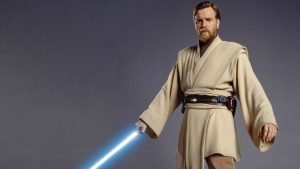We are officially in the last leg of the long journey to Star Wars: The Rise Of Skywalker, which means that the mighty Skywalker Saga, a story spanning forty years across films, books, comics, cartoons and video games is finally coming to a close – which in turn means that it’s time to reflect on that nine-part saga and take a good long look at the films that predate and inform Rise Of Skywalker‘s epic conclusion.
To do that, we’re going to have to discuss spoilers for each of the eight films in the Saga, so…SPOILERS AHEAD.
(Before we begin, be aware that I’m going through the list by order of release date: I understand that George Lucas wanted movies 4, 5 and 6 to be movies 1, 2 and 3 and to be treated as such – but they’re not good enough to warrant that distinction. Sorry, George).
Star Wars: A New Hope
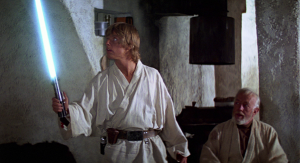
The movie that started it all: not just the opening chapter in the story of the Skywalker family and their tumultuous game of tug-of-war between opposing sides of the Force, but also the movie that birthed Hollywood’s current blockbuster trend (apart from the prequels, which were crushed under the hairy heels of hobbits, every Star Wars movie in the Skywalker Saga has been the highest-grossing movie in the year of its release). Star Wars is one of the defining checkpoints in cinematic history, and it will always have that distinction – few other films have shaped the entertainment industry, and pop culture in general, in the way that Star Wars did. Even in the days before the internet and social media, the film permeated every aspect of society, spawning merchandise, mantras, mannerisms, and that notorious Christmas special that George Lucas wants you to forget about. It makes Rise Of Skywalker all the more frightening – for the first time in forty-two years, the Star Wars franchise will have no clear direction, no overarching story, no Skywalker to follow into the future.
But as that future is still more than a week away, let us savor this moment of blissful ignorance and return to the craggy deserts of Tatooine, a remote planet nestled in a forgotten corner of the Outer Rim, somewhere long, long ago in a galaxy far, far away – an inconspicuous space rock that, for whatever reason birthed the Star Wars franchise’s most iconic hero and villain. The harsh sand is illuminated by the planet’s dual suns (duality is Star Wars‘ most constant theme: make a note of that), and crawling with Jawas, Tusken Raiders, and the handful of moisture farmers who call the desert home. It’s probably the most iconic locale in all of science-fiction. But after all this time, surely both Tatooine’s rugged charm and Luke Skywalker’s simplistic journey to heroism have been antiquated by the deluge of even larger, more epic sci-fi stories that erupted in the film’s wake?
Nope. That is to say: yes, some parts of A New Hope maybe aren’t quite as spectacular and compelling as they were in 1977 – but all in all, the film is still extremely entertaining, ridiculously fun, and brilliantly unique. There are things I love about the movie – there are also things that I strongly dislike. And, in a couple of situations, there are things which would work, but don’t anymore because of the events of other Star Wars movies. Let’s run through the list.
What is still great about A New Hope? So much. But above anything else – the film’s story. I called it simplistic, and it is: but it’s archetypal, so it has to be. Luke Skywalker (Mark Hamill) was never a very complex character in the original film – he was the standard white male protagonist whose inferior knockoffs have since infested every inch of genre fiction. Morally pure but headstrong, loyal but self-doubting, readily equipped with magic sword and grappling hook but pacifistic nevertheless (okay, the grappling hook is actually one of Luke’s more unique accessories: shamefully, it was only ever used once). Most of the ensemble cast are also fairly ordinary: the rogue with a heart of gold, the princess, the mentor figure unwillingly called out of retirement, the bumbling comic relief characters. And the film never does anything particularly unexpected or extraordinary with any of them – they go about their quest, and achieve it with a minimum amount of casualties (except for the mentor, of course: the mentor always dies). But there’s nothing wrong with a classic Hero’s Journey, and A New Hope arguably tells it better than almost any other example out there. And you have to first build a myth if you’re going to start deconstructing it.
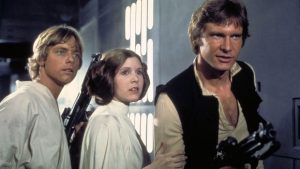
A New Hope also does a good job of disguising the fact that its characters are archetypes: for example, while Princess Leia (Carrie Fisher) is technically a “damsel in distress”, she never actually stresses or cracks under pressure. She resists the interrogations and torture methods employed upon her by the greatest Sith Lord in the universe, and even dares to lie to Grand Moff Tarkin (the fabulous Peter Cushing) in order to buy time for her friends: and once freed from prison, she grabs herself a blaster gun and takes part in the action. As soon as she returns to her Rebel hideout, she takes the reins and orchestrates the daredevil raid on the Death Star. And of course, she was the person entrusted with the Death Star plans in the first place.
And even if monomyths and archetypes are too cliché for some, they’re made new and invigorating by the story’s bold, high-concept sci-fi – a genre which has largely been synonymous with Star Wars ever since the first film’s release. George Lucas could easily have adapted the sleek, shiny, futuristic look of Star Trek into his own universe: but instead, he chose to go for a more realistic “used future”, one full of grit, grime, and rebel scum. This same basic principle – that a fantasy universe should and could feel lived-in, with a little help from a willing crew of craftspeople, costume designers and prop-makers – would later be adopted by Peter Jackson when making The Lord Of The Rings, which is why I felt it was necessary to add to my list.
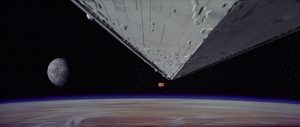
Building off of that: spaceships and aliens. From the film’s opening shot (which has been mirrored and referred back to many times since), Star Wars has always been, at least partially, about building bigger and bigger spaceships and then finding ways to blow them up – after all, there wouldn’t be any star war to speak of if the Empire didn’t have a gazillion TIE-fighters and star destroyers, or if the Rebellion wasn’t armed with their battered fleet of X-Wings (and one Millennium Falcon). A New Hope has some great scenes in space, and some incredible spaceships – not to mention the mighty Death Star, a weapon of mass destruction that would be a lot more intimidating if it wasn’t basically the only idea the Empire ever had. Every ship in Star Wars, whether built to weather the sands of Tatooine or the cold void of space, has its own little quirks and characteristics: even if it’s often impossible to remember every spaceship’s name (the Falcon, Tantive IV, um…), they’re all still easily distinguishable.
The aliens, while undoubtedly being some of Star Wars‘ most iconic characters, are rather few and far between in A New Hope. With each new movie in the franchise, the Rebellion has become more and more diverse, but the original film’s trusty team of fighter pilots consisted entirely of white men. Chewbacca the Wookie (Peter Mayhew) is the only alien present in the film’s epic finale (and it feels mean to call him an alien: Chewie is part of the family). This is something that feels even weirder when you consider that the crew of pilots and soldiers in Rogue One (which is set only about a week before the events of A New Hope) is much more diverse, with women, people of color, and aliens all piloting spaceships and taking part in the Rebellion. But there are enough aliens packed into the Mos Eisley spaceport on Tatooine to fill roughly thirty who’s-who books: Figrin D’an and his groovy band, the Modal Nodes; Greedo, the rubbery green rat who may or may not have shot first (more on that in a moment); Jawas, furtive junk-traders and robbers eternally swaddled in dark robes; the barbaric Tusken Raiders, who are indirectly responsible for Darth Vader; and of course, the mighty Jabba the Hutt, who was digitally added into the film during one of George Lucas’ many attempts to retouch the original trilogy with fancier special effects.
And now we have to get into the bad stuff: specifically, the awkward mishmash of VFX and practical effects that Lucas’ tampering is responsible for – in the late 90’s and early 2000’s, not content with allowing the original films to age gracefully, Lucas, who was at that point busy suffocating his prequel trilogy in horrendous CGI nonsense, decided to go back and insert some of his new favorite ingredient into the older films: the result is…unfortunate, to say the least. Not only because the CGI is bad, inconsistent, and messily applied, but also because it robs A New Hope of a lot of its charm. Is it kind of silly that spaceships and entire planets explode into sparkling smoke in the original film? Yes, of course: for example, it’s a bit of a downgrade to go from watching 2016’s Rogue One (which, again, is set only a few days before A New Hope), which does a great job of displaying the Death Star’s horrific powers – to the original Death Star, which just zaps planets out of existence in two seconds with a pyrotechnics flash, before itself being zapped. But that wasn’t even the only sort of thing that George Lucas was interested in changing: apparently dissatisfied with the story he had crafted, he also edited scenes differently to present different narratives – which is how we ended up with the “Han shot first” debacle.
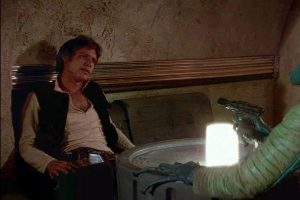
The “Han shot first” debacle is the Star Wars fandom’s equivalent of “do Balrogs have wings?”, or “how did Steve return the Soul Stone?”. Back in 1977, it wasn’t even a question: when Han Solo (Harrison Ford) was accosted by the green space alien mercenary Greedo (Paul Blake) in the Mos Eisley cantina, he undeniably shot first, before Greedo had a chance to move. And for most people, that was perfectly fine: it was totally in character for the rogue, and it was a cool, tense scene. But for George Lucas, it painted Han Solo as a merciless killer, so he tinkered with it to add in a few frames where Greedo shoots first, missing Han (which doesn’t even make sense, considering he was sitting about two feet away from him), and giving Han justification for firing back. In 2004, Lucas changed it again, having both Han and Greedo fire at the same time, with Han somehow dodging Greedo’s shot. And now, the controversy has been stirred up again by the Disney+ version of the film, which gives Greedo an added line of dialogue, in which he threatens Han with the menacing word “maclunkey” before shooting. The debacle has sparked outrage on both sides of the argument: Lucas claims that it was always meant to be that way (despite original scripts proving otherwise); Paul Blake is outraged that his character shot first, saying it makes Greedo look pathetic for missing at such short range; and Harrison Ford doesn’t know or care who shot first. The question of which version is “right” is bound to linger for many more years to come. For more info on the subject, you can check out Wikipedia’s entire article on “Han shot first”.
Lucas’ meddling has done a great deal of damage to the franchise: the attempt to blend the styles of the first two trilogies into one cohesive whole isn’t necessarily a bad idea, but it doesn’t work; Lucas’ insistence that 1977 audiences accidentally fell in love with only “half a completed film” feels like a slap in the face to the franchise’s earliest fans; and his eventual decision to step away from Star Wars entirely seems, in hindsight, like sore losing, as if he can’t quite understand that his films don’t need to be 100% perfect in order to be good. They’re beloved classics already: they should remain classic.

So does A New Hope still hold up after all this time? I think that, if you can look past the film’s very few flaws (most of which are the fault of George Lucas’ perfectionism), then you’ll find that the very first Star Wars movie is still one of the franchise’s very best. It’s not as visionary as The Empire Strikes Back or The Last Jedi, nor even as complex as The Revenge Of The Sith, but it’s still just as much (if not more) fun than all three of those entries.
Movie Rating: 8.5/10
